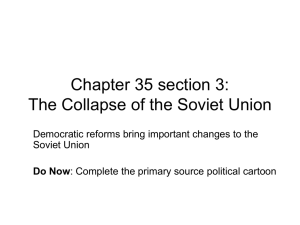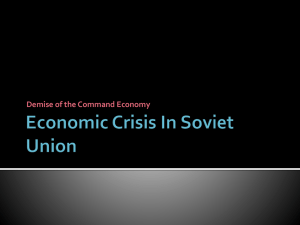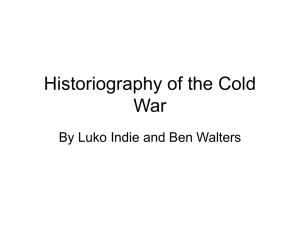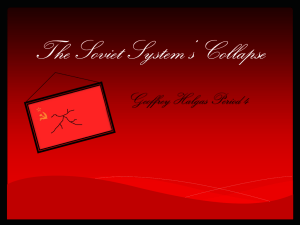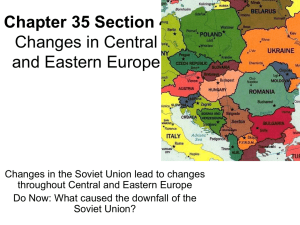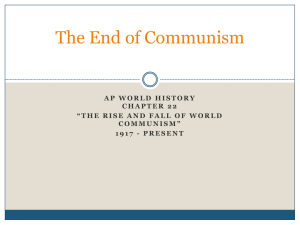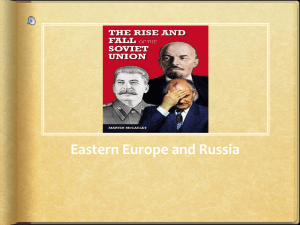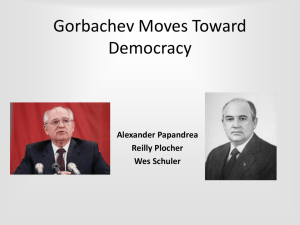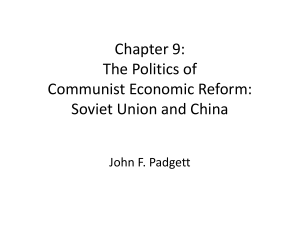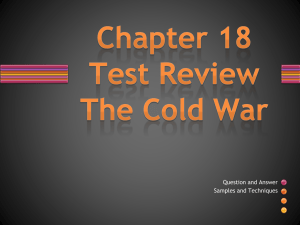End of the Cold War in Europe
advertisement
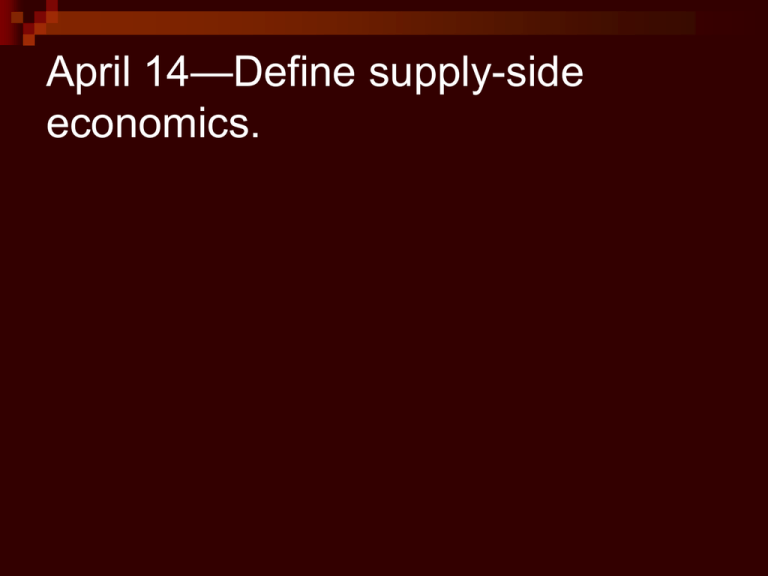
April 14—Define supply-side economics. End of the Cold War 1979-1991 IB Objectives End of the Soviet Union IB Sample Questions Evaluate the role of one superpower in the Cold War after 1970. To what extent did economic problems in the Communist bloc bring about the end of the Cold War? When and why did the Cold War end? Key Terms Mikhail Gorbachev Lech Walesa SDI INF Treaty Perestroika Glasnost Congress of People’s Deputies Boris Yeltsin Lecture Outline I. Mikhail Gorbachev II. Poland and Afghanistan III. Fall of Communism in Eastern Europe IV. Gorbachev’s reforms V. The Collapse of the Soviet Union Mikhail Gorbachev Was born in 1931 Became a provincial party chief in 1970. In 1978 he became the CPSU’s Secretary of Agriculture. Became the Communist Party’s Chairman in March 1985. Reagan Took office in 1981 “Soviet Union is the focus of evil in modern world.” First 3 yrs in office, he increased defense spending, adjusted inflation by 40%, and abandoned Carter’s human rights policy. Poland In 1981 the Soviet Union forced the Polish army to impose martial law in order to crush Solidarity, a trade union under the leadership of Lech Walesa. What caused the fall of Communism in Eastern Europe? 4 decades of containment by NATO The burden of the arms race The people of Eastern Europe’s refusal to abandon their hopes for freedom Communism as practiced by the Russians was an awful system. Fall of Communism in Eastern Europe In January 1989 Gorbachev reduced the Soviet military by 14%. The Estonian legislature voted to give Estonian preference over Russian as the official language. In April 1989 the Polish government signed an agreement with Solidarity make it legal and setting open national elections for June. Fall of Communism in Eastern Europe In June 1989 Gorbachev effectively put an end to the Brezhnev doctrine. In August 1989 Solidarity won 99 out of 100 seats they were allowed to contest and a Solidarity leader became Prime Minister. In November 1989 anti-Communist dissident Vaclav Havel came out of prison and soon was elected president of Czechoslovakia. Fall of Communism in Eastern Europe On November 9, 1989 the East German government announced that “it is now possible for all citizens to leave this country through East German crossing points.” Within hours, tens of thousands of East Germans and West Berliners began tearing down the Berlin Wall. Fall of the Berlin Wall Fall of Communism in Eastern Europe President Bush and Gorbachev met at Camp David and agreed to reduce the number of their long-range nuclear weapons by 30% and their chemical weapons stockpile by 80%. In 1991 the Warsaw Pact was dissolved. Fall of Communism in Eastern Europe In March 1990 the parliament of Lithuania voted to secede from the Soviet Union and the Estonian and Latvian parliaments declared “transitional periods” to independence. Strategic Defense Initiative (SDI) Nov. 1985 Gorbachev and Reagan attend first summit meeting together. Reagan earlier had called for a 50% reduction in nuclear weapons and an expanded SDI, a missile defense program that would end the ABM treaty and cause the US and USSR to greatly increase defense expenditures. Reagan refused to back down and no agreement was made. Intermediate Range Nuclear Force (INF) Treaty When Gorbachev took over, Soviet military expenditures accounted for 20-30% of the Soviet GDP (at the peak of the Reagan defense buildup, US defense spending was 6.5% of the US GDP. In December 1987, in Washington D.C., Reagan and Gorbachev signed the INF Treaty, which called for the destruction of all short and medium range nuclear-tipped missiles. It was a breakthrough because it actually provided for the elimination of major weapons systems and it significantly reduced tensions in Europe. Afghanistan Gorbachev allocated more money to defense, and authorized an offensive to break the stalemate of the Afghanistan War. 50,000 Soviet casualties In April 1988, Gorbachev ordered a phased Soviet withdrawal from Afghanistan that was completed in February 1989. First time in 33 years that the Red Army had pulled back from anywhere. Soviet Economy By the end of the 1980s the entire Soviet Union had just 200,000 desktop computers while the US had 25 million. Perestroika Gorbachev relaxed central controls of the economy while keeping state ownership and oversight of the economic system. Begins in 1986 with market-like reforms. Legalizes certain kinds of co-operatives and people begin to open privately owned restaurants. 1987—Legalizes foreign investment but not ownership. Decentralizes economic planning. Shifts to local levels. Effects of Perestroika Economy gets worse. Creates party resistance which results in many of the reforms not be enacted. Gorbachev begins to attack bureaucrats and party conservatives which results in him creating glasnost. Glasnost In April 1986 the world’s worst nuclear disaster took place at Chernobyl. The denials by Soviet officials forced openness or glasnost. Glasnost During 1986-87, the Soviet media set out to demonstrate a necessity for change by publicizing many previously forbidden topics. People viewed it as more party propaganda not openness. Glasnost Gorbachev wanted openness in the Communist Party not the public. Was concentrated mostly in Moscow and Leningrad New publications emerged, including uncensored newspapers. Glasnost Banned books were now available. Many people were learning about Soviet tragedies such as Stalin’s actions, pollution, nuclear power and waste including Chernobyl for the first time. Began to learn of the standard of living in Europe and the US which resulted in people feeling that there country was uncivilized. Glasnost Allowed for freedom of assembly which allowed for the creation of political groups who aimed to reform the USSR. After Glasnost the old system was rejected by most of the citizens of the Soviet Union. Most people under 30—1/4 of the Soviet population—were simply not interested in reforming Communism. Congress of People’s Deputies In July 1988 Gorbachev attempted to decentralize the authority of the Party’s Central Committee by authorizing open elections for a new body, a Congress of People’s Deputies (CPD), which would in turn choose representatives to the USSR Supreme Soviet, or parliament. CPD 2,250 deputies Divided into groups of 750 from territories, ethnic regions, and party chosen. 2/3 were elected. 1/3 chosen Nominations, registration, and campaigning began in 1989 Voting occurs March 26, 1989; 90% turnout Boris Yeltsin, Gorbachev’s protégé, became the representative from Moscow. CPD Meets for the first time on May 25, 1989 The election process shows how inept the Communist Party (CPSU) was. Party officials losing elections was humiliating and made the CPSU lose legitimacy and confidence. Constitutional Reforms 1990 Creates office of the President who is elected by the CPD Removal of Article 6 which gives the CPSU the “leading role” Russian Republic CPD Holds elections in 1990. Results: 1/3 Democratic Russians, 1/3 CPSU deputies; 1/3 independent deputies. First meets in May 1990 Boris Yeltsin become chairman of Russian CPD and he wants to write a new constitution and create a Russian president. Russian Republic CPD Begins to pass laws that contradict USSR CPD which results in a conflict. Yeltsin passes a law that gives the Russian Republic economic sovereignty which results in other republics doing the same. All of this results in the economy ceasing to function. Russian Republic Yeltsin resigns from CPSU in summer of 1990 and thousands of Russians follow him. 1990 is the beginning of a depression in Russia that lasts 10 years. Gorbachev is blamed for everything Fall 1990 Gorbachev turns to the right and away from reform in order to keep his job. End of Reform Jan 1991 Soviet CPD made censorship legal again. April 1991 Russian presidency is created. April 1991 Gorbachev calls for the creation of a Union Treaty which would give more power to the leaders of the republics. This threatens the national institutions. Conservatives begin to plan a coup. Yeltsin is elected Russian president in June 1991. The Collapse of the Soviet Union In August 1991, reactionaries in the Red Army and the Communist Party staged a coup against Gorbachev. Begins August 18, public becomes aware Aug. 19 and it ends Aug. 21. In Moscow, Russian President Boris Yeltsin called for a general strike and resistance to the coup on Aug. 20 after receiving a note of support from Pres. Bush. The coup collapsed in 3 days. Collapse of the Soviet Union Coup bestowed an incredible amount of legitimacy on Yeltsin. Gorbachev returns but is discredited. Yeltsin passes a decree that makes the Soviet CPSU illegal. December 25, 1991 Gorbachev signs over control of the nuclear arsenal to Yeltsin which is a symbolic end of the USSR.
